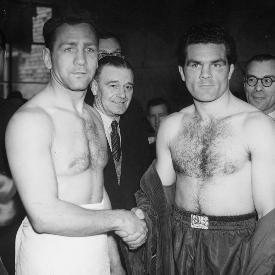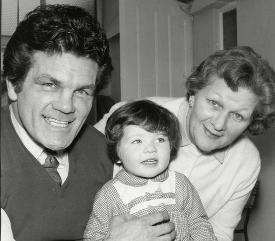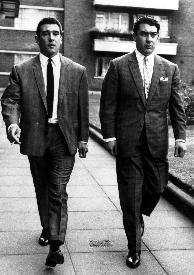On the balmy evening of 24th July 1965, three people set off to enjoy their Saturday night, driving from suburban London to a nightclub in Soho. This was the beating heart of London in the ‘swinging sixties’, a glamorous (if more than a little seedy) area where celebrities mixed with ambitious social climbers, where European royalty mixed with the newly wealthy.
The three people were accustomed to this world. They were Don McCorkindale Jr, his wife, Kate McCorkindale, and his mother, Christine Mills. They were setting off to meet the owner of the club, who just so happened to be Christine’s husband, and Don’s step-father. They were setting off to meet Freddie Mills.
Freddie Mills was more than just a nightclub owner. He was a retired boxing champion, famous across Britain and much of the world for his sporting exploits. He was a larger-than-life, gregarious character who had also served as a soldier during the second world war, and had even tried his hand at acting after his retirement. He was one of the most famous faces in Britain, and he was spending his Saturday night, as usual, at his nightclub in Soho.
At around half-past midnight, Don McCorkindale pulled into the road behind the club and parked up next to Freddie’s grey Citroen. But peering through the darkness, he noticed something strange. He noticed that Freddie Mills was sitting upright, not in the driver’s seat, but in the back passenger seat. He was motionless, not reacting to the sound of Don pulling up and getting out of his car next to him.
Still, Don didn’t think anything untoward had occurred. It wasn’t unusual for Freddie to have a nap in his car. Or perhaps he had just had too much to drink, and someone had put him there.
Don opened the passenger door and slapped Freddie on the knee, saying ‘Come on Freddie, time to get up!’
But Freddie Mills did not move.
Don’s thoughts were interrupted by a shriek from his mother. Christine Mills had opened the other passenger door, and seen the rifle sitting next to Freddie.
‘Donny, it’s a gun! Call an ambulance!’
But Don McCorkindale quickly saw that it was too late to call an ambulance. He saw that Freddie Mills had a gaping wound in his right eye.
Freddie Mills was already dead.
Boxing Hero
Frederick Mills was born on 26th June 1919, the youngest of four children born to Thomas and Lottie Mills in Bournemouth, on the south coast of England. He showed early promise in several sports, but his was a boxing family – his elder brother Charlie was a keen boxer and young Freddie would spar with him, perhaps in a prelude to his later reputation for fearlessly taking on more established boxers than himself.
After leaving school, Freddie worked part time as a gardener but it was not long before he turned his hobby into a career. He signed professional forms in his teens but would not compete in any packed arenas yet – instead, he spent a few years touring the country as a popular fairground attraction, fighting in makeshift tents in front of enthusiastic locals. He was professional in the sense that he was making his living from boxing, but it was hardly glamorous.
Freddie’s big break came in August 1940, by which time he had joined the army after the breakout of the second world war. During a period of leave he found time to fight Jock McAvoy, the middleweight champion in the British Empire and Commonwealth. That a 21-year-old upstart would challenge such an established fighter was one thing; that the young man would beat the champion was quite another. But this is what Freddie Mills did, winning on a points decision after ten rounds.
People noted his slightly unconventional approach to boxing – Mills did not seem to care for skill or intricacy, instead looking to soak up hits from his opponents before overwhelming them with fast, powerful punches. At 5 feet 11 he was not especially tall, but he had a formidable build and could recover from punches that would have knocked most of his peers out.
He continued his impressive run throughout the war, moving up a class to fight the Empire heavyweight champion Jack London in December 1941, before beating Jock McAvoy again in 1942. This set up a fight for British Empire and Commonwealth light-heavyweight title, which Freddie clinched with a victory over the reigning champion, Len Harvey, in front of 30,000 people at London’s White Hart Lane stadium in June 1942.
Mills tried for the world heavyweight title against American Gus Lesnevich, and clinched the crown at the second time of asking in 1948. He could now claim that he was not only a British champion, but a world champion. He had reached the pinnacle of his career.
Mills shakes hands with the legendary American boxer Gus Lesnevich (The Guardian)
Family, Acting and other ventures
Freddie Mills’ boxing career never quite reached those heights again. He lost his world crown to another American boxer, Joey Maxim, in February 1950 and retired soon after. He still kept a foot in the boxing world, gaining a promoter’s licence in 1951 and doing commentary work for the BBC on the television and radio throughout the decade.
Mills also appeared on various comedy sketch shows and even presented a pop music programme on the BBC. Television was still very much in its infancy at this time, but it still allowed Mills to reach an audience who perhaps had not known him for his boxing exploits. By 1960, Freddie Mills was one of the most well-known people in Britain.
Amid his post-boxing ventures, Mills also attended to his growing family. In the 1940s he had been introduced to Christine McCorkindale, who was married to the South African boxer Don McCorkindale. Freddie and Christine began an affair and got married themselves in 1948. Freddie became stepfather to Christine’s son, Don Jr, and had two daughters of his own with Christine – Susan (born 1952) and Amanda (born 1958). Despite his well-earned reputation as a fearsome fighter, Freddie was a doting husband and father. In a recent BBC documentary about his death, Don Jr, Susan and Amanda all spoke lovingly about their father and expressed that they had only fond memories of him. The family settled in Denmark Hill, south London.
A summer’s night in 1965
Of course, the other arena that Freddie Mills had ventured into was nightclub ownership. In fact, his spot in Soho had originally been opened as a Chinese restaurant, but with that business starting to fail Freddie had decided to cash in on his increasing fame and re-brand the venue as ‘The Freddie Mills nightspot.’ He tried to make it as glamorous as possible, commissioning a red velvet décor and inviting celebrities to its opening, and for a while the ploy worked. He raked in the profits as people from across Britain paid good money to mingle among the stars and perhaps even catch a glimpse of the boxing great himself.
But by the mid-1960s, Freddie Mills’ business had taken a nosedive. His media work started to become infrequent, and as his television appearances dried up, so did his customers. By 1965 he and his business were heavily in debt, and there was no real prospect of relief. Freddie Mills was yesterday’s man, and spiralling toward financial ruin.
All of this could explain why his death, on the evening of 24th July 1965, was ruled as a suicide. He was known to have been suffering from depression because of his financial circumstances, and as a result of the punishment his head had taken during his boxing career. He knew as well as anyone that his future, at least in the short term, did not look bright. Perhaps it had all just become too much for him, and he had decided suicide was his only way out.
This theory could be said to be supported by the physical evidence – after all, the rifle that killed him was found next to his body. And it was a rifle that was in his possession – inquiries confirmed that he had borrowed it from a friend.
But does that necessarily prove anything? Despite his depression, was he really suicidal?
Or, had Freddie Mills’ forays into the murky nightlife scene in 1960s London made him enemies that he could not despatch with a few powerful punches?
Who exactly did he owe money to?
Freddie Mills was depressed not only because he was struggling financially, but because he knew his life was in danger.
Was Freddie Mills suicidal?
The main hole in the various murder theories that have been put forward is that Mills was killed with his own gun (or at least a gun he had borrowed from a friend). But that is not proof that his death was by his own hand. He could have been ambushed and forced to hand over the gun under duress. Perhaps he let his guard down and allowed the gun to be snatched from his reach, or perhaps the gun went off in a struggle. In any case, there appears to be too many holes in the suicide theory for it to be considered airtight.
Freddie Mills’ family never accepted the official verdict of suicide. His daughters speak movingly about his lust for life in the aforementioned BBC documentary, but they were too young at the time to have had a real sense of whether he was suicidal or not. More compelling is the adamance of his late wife, Christine, and his stepson, Don Jr, that he would never have taken his own life.
The obvious caveat is that it is not uncommon for families of suicide victims to deny that their loved one was suicidal, but the fact that Christine and Don Jr had organised to meet Freddie that evening must surely give pause for thought. Why would he have killed himself knowing that he would be discovered by his loved ones?
The hints of a cover-up must also be acknowledged. For a start, despite the fact that Mills was very obviously dead, his body was bundled into an ambulance and taken to hospital before the police were even notified, and this disturbing of the crime scene left the police unable to properly assess whether Mills’ wounded had been self-inflicted or not.
Even if they had properly assessed the crime scene, would the police have been inclined to properly pursue the case?
The quick verdict of suicide went against much evidence that a thorough detective would have noted – a shot through the eye being a highly unusual method of suicide, for one thing, and the fact that Mills’ eye was not closed (as it instinctively would have been if he had been expecting a bullet) for another. In the BBC documentary examining the case, a medical officer at the hospital Mills’ body was taken to remembers being shocked at the death being ruled a suicide, and relays his suspicion that the police did not want to go anywhere near the case.
Perhaps they were ordered not to go near it by an outside actor, or perhaps they did not want to go near it because they were afraid of what they might find.
So, what, or who, would they have found?
The Kray twins
On the opening night of the Freddie Mills night spot, two men shook the boxer’s hand and congratulated him warmly. Freddie Mills was easily taller and more powerful than them, but their presence made his blood run cold. He knew that their friendly greeting meant nothing.
The two men were the notorious Kray twins, Ronnie and Reggie, the most infamous gangsters in 20th century Britain. They were wealthy, extremely powerful and incredibly violent, and had now decided to invest in Freddie Mills’ nightclub as a way of maintaining their already considerable influence in London’s nightclubs. The Krays were no doubt pleased with the success of that opening night, dreaming of the profits they were about to make.
But when Freddie Mills’ nightclub started to fail, the Krays stood to lose their investment. Could it be that they resorted to murdering him when he failed to pay them back?
Freddie Mills was a known associate of the notorious Kray twins (The Sun)
Another interesting point to note at this juncture is that the Kray twins may have thought that Freddie Mills was responsible for a series of murders in west London over the previous couple of years – a fact which I have alluded to in this blog, and on my podcast. Now, I think it unlikely that Mills was the notorious ‘Jack the Stripper’, for reasons I have outlined in that blog piece and podcast – the suspect was likely a small, diminutive man (unlike Freddie Mills), was likely an industrial worker in suburban west London (unlike Freddie Mills) and more compelling evidence points to a Welshman named Harold Jones (definitely not Freddie Mills). Besides, a witness saw one of the victims climb into a car with the probable killer, and would have definitely remembered if the person behind the wheel was Freddie Mills, one of the most recognisable faces in the country.
But the Kray twins did not know any of that. All they knew was that at least six, and probably eight, women had fallen victim to the same serial killer over the previous couple of years, and they thought Freddie Mills was behind it. The Krays were violent men but they had a twisted sense of honour – for example, they never swore – and it could be possible that they were enraged at the thought that Mills had killed so many innocent women. Or perhaps they thought that Mills would be caught eventually and that their operation with him would be in jeopardy.
Neither the murder nor the cover-up would be beyond the Kray twins. They were extraordinarily violent men, and they controlled much of London’s police force, so the idea of them organising the hit and then having the police quickly whisk the body away and declaring it a suicide is not far-fetched at all.
Other Mobsters
The Krays were the most infamous gangsters of 1960s London, but they certainly weren’t the only show in town. The city, and Soho in particular, was teeming with criminal gangs and corrupt policemen and any number of them could have had an interest in Freddie Mills’ nightclub. Indeed, many of them did. Mills was heavily in debt to several gangsters in the area and it is possible, likely even, that he was killed by them.
There is even one theory, put forward by Richard Bevan on the Crime and Investigation website, that a hit on Mills was arranged by the legendary American mobster Meyer Lanksy. This theory suggests that Lansky selected the boxing promoter Benny Huntman – a known associate of Mills – to be his man in London, and that when Mills found out about this he desperately tried to extort thousands of pounds from Huntman, threatening to tell the press about his ties to the American mafia if he did not pay up. Huntman informed Lansky of Mills’ attempted blackmail, so Lansky ordered that Mills be murdered.
This theory relies almost entirely on the testimony of Huntman’s son, Roger, who says that Mills was waiting in the back seat of his car to receive his money when he was shot. Again, it cannot be proven, but it is an intriguing thought.
We will never know for sure
Freddie Mills’ death will likely never be solved properly, but it is this writer’s opinion that he did not kill himself. There was no evidence that he was suicidal, he had no shortage of enemies who were out to get him, and the disturbing of a potential crime scene and quick verdict all feels rather convenient.
Mills is not so well remembered in the modern day, but his was a rags to riches story that epitomised mid-20th century Britain. Brave and gregarious, he had worked his way from obscure poverty in Dorset to the beating heart of London in the swinging sixties. Unfortunately, it was this foray into the swinging city that cost him his life.
Like this article? Explore the blog for more great content, and DONATE HERE! The blog needs your help to keep going!
https://www.buymeacoffee.com/tomMOH
Cover Image - The Irish Sun
‘Freddie Mills: Death of a sporting hero’, article on Crime and Investigation website by Richard Bevan -
https://www.crimeandinvestigation.co.uk/article/freddie-mills-death-of-a-sporting-hero
‘Murder in Soho: Who killed Freddie Mills?’ Documentary produced by the BBC (2018) -
https://www.bbc.co.uk/iplayer/episode/b0bcy56k/murder-in-soho-who-killed-freddie-mills

.jpg)


